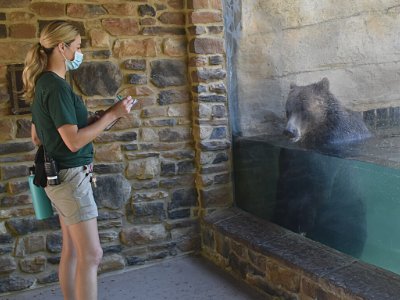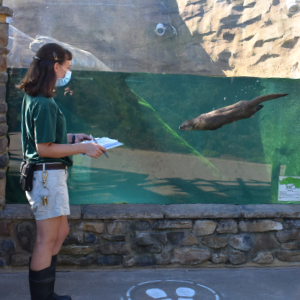There is much more to being a keeper than one may think. As keepers, we pour our hearts and souls into providing the best possible care for all of our animals. We enrich our animals daily, form relationships and build trust through training, assist in medical procedures, administer medications, rebuild and remodel enclosures, promote conservation, rehabilitate wild animals, and promote breeding of endangered and even extinct species; and that’s just the tip of the iceberg!
 One of the most important things that keepers do is conduct research. We are scientists after all! Every day, keepers make formal behavioral observations for many of the animals at the zoo. When evaluating an animal’s wellbeing, animal behavior is extremely important to understand. By knowing the natural history of the species and the background and personality of specific individuals, a keeper can observe and identify which behaviors are normal for a species or individual, and which are not. We can then use this information to modify and enhance the way we care for our animals by adjusting diet items, switching up enrichment and even modifying general management and care.
One of the most important things that keepers do is conduct research. We are scientists after all! Every day, keepers make formal behavioral observations for many of the animals at the zoo. When evaluating an animal’s wellbeing, animal behavior is extremely important to understand. By knowing the natural history of the species and the background and personality of specific individuals, a keeper can observe and identify which behaviors are normal for a species or individual, and which are not. We can then use this information to modify and enhance the way we care for our animals by adjusting diet items, switching up enrichment and even modifying general management and care.
Let’s take a closer look at how conducting animal behavioral research works. First, we compose an ethogram, or a list of behaviors relevant to the species that will be observed. This list incorporates behaviors and activities such as energy levels, behavioral tendencies, communication styles, reproduction behaviors and more. Once this ethogram is in place, we are able to start observations and compare them to behaviors that are expected. An animal’s behavior is observed for a predetermined amount of time using a timer, and the behavior that was displayed for the majority of that time period will be recorded. We also note where the animal’s located in their habitat, the temperature outside and any other factors that may contribute to their behavior that day. Data is collected twice daily, at roughly the same times each day. Once enough data has been collected, we are able to build graphs and charts to examine any trends in our animal’s behavior. We can then make management and care decisions based on our findings.
This collection of data helps us to make real, scientific conclusions about our animals, instead of assumptions. For example, we might see a day when boomer balls have been provided to our grizzly bears for enrichment, but Cheyenne is disinterested. Instead of thinking “Cheyenne dislikes that ball,” we can look at trends in our data to determine her level of previous interest in boomer balls and other enrichment items. After reviewing the data, we may conclude a statement more along the lines of “The grizzly bear, Cheyenne, was observed interacting with enrichment every day this month, except for days when she was given a boomer ball.” From this analysis, we may choose to modify her enrichment schedule not to include boomer balls, making Cheyenne a more active bear!
 Behavioral observations were also an incredibly valuable resource during our closure due to the coronavirus pandemic. Since many of our animals were born and raised in zoos, they have not known life without the presence of guests. Many people speculated that our animals would miss having guests, while others supposed our animals would enjoy the quiet, and this presented the perfect opportunity to find out for ourselves! We continued to conduct formal behavioral observations twice daily with many of our animals, in the hope that we could determine if and how animal behavior has changed as a result of not having guests. We are still working on obtaining this data and are hopeful we will find out soon if the presence or absence of guests significantly impacted our animal’s behavior.
Behavioral observations were also an incredibly valuable resource during our closure due to the coronavirus pandemic. Since many of our animals were born and raised in zoos, they have not known life without the presence of guests. Many people speculated that our animals would miss having guests, while others supposed our animals would enjoy the quiet, and this presented the perfect opportunity to find out for ourselves! We continued to conduct formal behavioral observations twice daily with many of our animals, in the hope that we could determine if and how animal behavior has changed as a result of not having guests. We are still working on obtaining this data and are hopeful we will find out soon if the presence or absence of guests significantly impacted our animal’s behavior.
Animal behavioral research is really one of the biggest keys to unlocking greater potential for zoos and aquariums around the world in terms of animal management and care. At the Akron Zoo, we are always striving to improve and advance how we care for our animals with the purpose of giving each and every one of them the best quality of life possible, and the first step to do that is conducting this type of research. As an animal care professional, I am extremely proud to work for an organization that is so invested in learning about our animals as well as constantly evolving and shaping how our animals are cared for.
